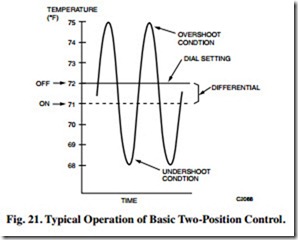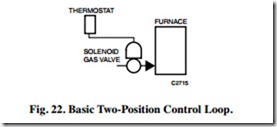BASIC TWO-POSITION CONTROL
In basic two-position control, the controller and the final control element interact without modification from a mechanical or thermal source. The result is cyclical operation of the controlled equipment and a condition in which the controlled variable cycles back and forth between two values (the on and off points) and is influenced by the lag in the system. The controller cannot change the position of the final control element until the controlled variable reaches one or the other of the two limits of the differential. For that reason, the differential is the minimum possible swing of the controlled variable. Figure 21 shows a typical heating system cycling pattern.
The overshoot and undershoot conditions shown in Figure 21 are caused by the lag in the system. When the heating system is energized, it builds up heat which moves into the space to warm the air, the contents of the space, and the thermostat. By the time the thermostat temperature reaches the off point (e.g., 72F), the room air is already warmer than that temperature. When the thermostat shuts off the heat, the heating system dissipates its stored heat to heat the space even more, causing overshoot. Undershoot is the same process in reverse.
In basic two-position control, the presence of lag causes the controller to correct a condition that has already passed rather than one that is taking place or is about to take place. Consequently, basic two-position control is best used in systems with minimal total system lag (including transfer, measuring, and final control element lags) and where close control is not required.
Figure 22 shows a sample control loop for basic two-position control: a thermostat turning a furnace burner on or off in response to space temperature. Because the thermostat cannot catch up with fluctuations in temperature, overshoot and undershoot enable the temperature to vary, sometimes considerably. Certain industrial processes and auxiliary processes in air conditioning have small system lags and can use two-position control satisfactorily.

